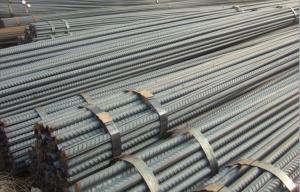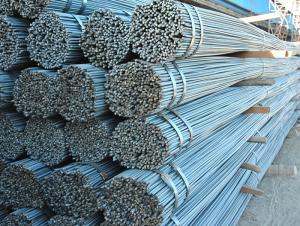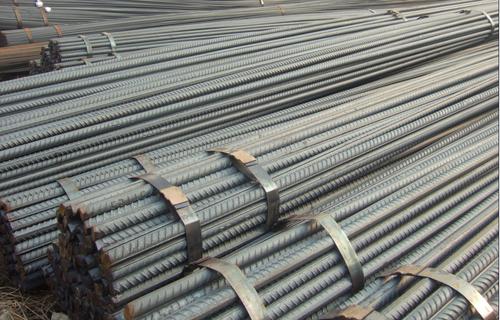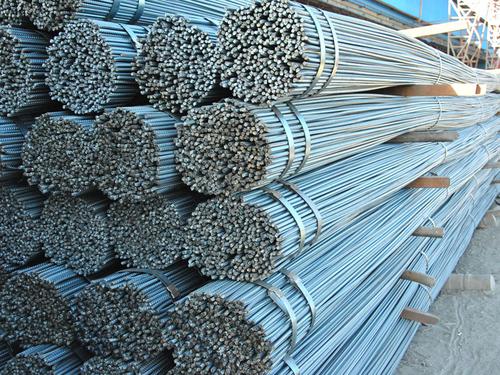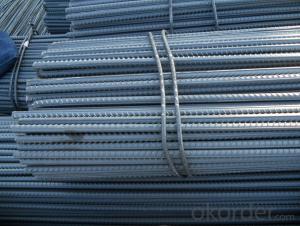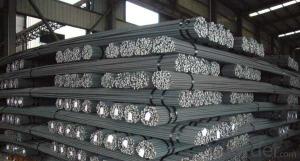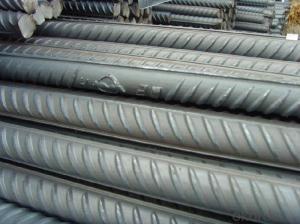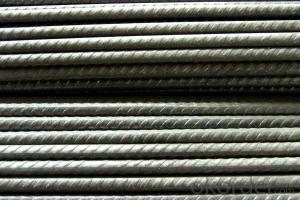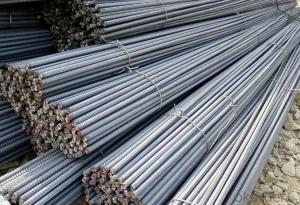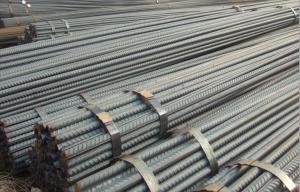Deformed Steel Bar 6mm-50MM ASTM A615 Or BS4449
- Loading Port:
- China Main Port
- Payment Terms:
- TT or LC
- Min Order Qty:
- -
- Supply Capability:
- -
OKorder Service Pledge
OKorder Financial Service
You Might Also Like
Product Description:
OKorder is offering Deformed Steel Bar 6mm-50MM ASTM A615 Or BS4449 at great prices with worldwide shipping. Our supplier is a world-class manufacturer of steel, with our products utilized the world over. OKorder annually supplies products to European, North American and Asian markets. We provide quotations within 24 hours of receiving an inquiry and guarantee competitive prices.
Product Applications:
Deformed bar is widely used in buildings, bridges, roads and other engineering construction. Big to highways, railways, bridges, culverts, tunnels, public facilities such as flood control, dam, small to housing construction, beam, column, wall and the foundation of the plate, deformed bar is an integral structure material. With the development of world economy and the vigorous development of infrastructure construction, real estate, the demand for deformed bar will be larger and larger
Product Advantages:
OKorder's Deformed Steel Bar 6mm-50MM ASTM A615 Or BS4449 are durable, strong, and resist corrosion, exact size, regular package, chemical and mechanical properties are stable.
Main Product Features:
· Premium quality
· Prompt delivery & seaworthy packing (30 days after receiving deposit)
· Corrosion resistance
· Can be recycled and reused
· Mill test certification
· Professional Service
· Competitive pricing
Product Specifications:
Manufacture: Hot rolled
Grade: BS4449
Certificates: ISO, SGS, BV, CIQ
Diameter: 6mm,8mm,10mm,12mm,14mm,16mm,18mm,20mm,
22mm,25mm,28mm,32mm,36mm,40mm,50mm
Length: 6M, 9M,12M or as required
Packaging: Export packing, nude packing, bundled
Chemical Composition: (Please kindly find our chemistry of our material based on HRB500 as below for your information)
Grade | Technical data of the original chemical composition (%) | ||||||
C | Mn | Si | S | P | V | ||
HRB400 | ≤0.25 | ≤1.60 | ≤0.80 | ≤0.045 | ≤0.045 | 0.04-0.12 | |
Physical capability | |||||||
Yield Strength (N/cm²) | Tensile Strength (N/cm²) | Elongation (%) | |||||
≥400 | ≥570 | ≥14 | |||||
Theoretical weight and section area of each diameter as below for your information:
Diameter(mm) | Section area (mm²) | Mass(kg/m) | Weight of 12m bar(kg) |
6 | 28.27 | 0.222 | 2.664 |
8 | 50.27 | 0.395 | 4.74 |
10 | 78.54 | 0.617 | 7.404 |
12 | 113.1 | 0.888 | 10.656 |
14 | 153.9 | 1.21 | 14.52 |
16 | 201.1 | 1.58 | 18.96 |
18 | 254.5 | 2.00 | 24 |
20 | 314.2 | 2.47 | 29.64 |
22 | 380.1 | 2.98 | 35.76 |
25 | 490.9 | 3.85 | 46.2 |
28 | 615.8 | 4.83 | 57.96 |
32 | 804.2 | 6.31 | 75.72 |
36 | 1018 | 7.99 | 98.88 |
40 | 1257 | 9.87 | 118.44 |
50 | 1964 | 15.42 | 185.04 |
FAQ:
Q1: How do we guarantee the quality of our products?
A1: We have established an advanced quality management system which conducts strict quality tests at every step, from raw materials to the final product. At the same time, we provide extensive follow-up service assurances as required.
Q2: How soon can we receive the product after purchase?
A2: Within three days of placing an order, we will begin production. The specific shipping date is dependent upon international and government factors, but is typically 7 to 10 workdays.
Q3: What makes stainless steel stainless?
A3: Stainless steel must contain at least 10.5 % chromium. It is this element that reacts with the oxygen in the air to form a complex chrome-oxide surface layer that is invisible but strong enough to prevent further oxygen from "staining" (rusting) the surface. Higher levels of chromium and the addition of other alloying elements such as nickel and molybdenum enhance this surface layer and improve the corrosion resistance of the stainless material.

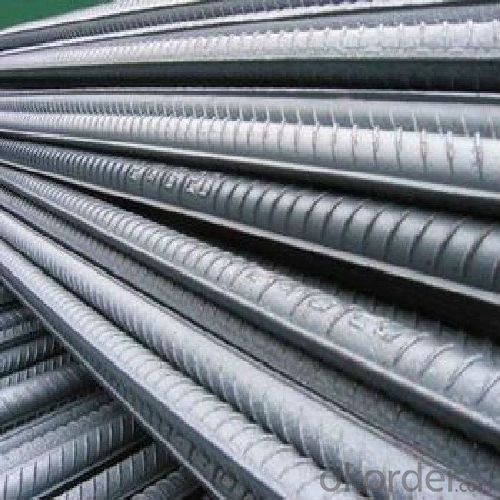
- Q: What are the different types of steel rebars used in tunneling?
- There are typically two types of steel rebars used in tunneling: epoxy-coated rebars and stainless steel rebars. Epoxy-coated rebars are commonly used in tunneling projects to provide corrosion resistance and enhance durability. On the other hand, stainless steel rebars are used in situations where higher corrosion resistance is required, such as in highly acidic or alkaline environments.
- Q: Are steel rebars fire resistant?
- Yes, steel rebars are fire resistant.
- Q: How do steel rebars affect the overall creep and shrinkage of concrete structures?
- Steel rebars have a significant influence on the overall creep and shrinkage of concrete structures. The presence of rebars helps to control and minimize the shrinkage of concrete by providing restraint and reducing the amount of drying shrinkage. Additionally, rebars contribute to the overall stiffness of the structure, decreasing the potential for creep deformation over time. Therefore, steel rebars play a crucial role in mitigating both creep and shrinkage in concrete structures, ensuring their stability and durability.
- Q: How are steel rebars different from steel mesh?
- Steel rebars and steel mesh are both reinforcing materials used in construction, but they differ in terms of their shape, size, and application. Steel rebars are long, cylindrical bars typically made of carbon steel and are used to provide tensile strength and stability to concrete structures, such as beams, columns, and foundations. On the other hand, steel mesh consists of a grid-like pattern of interconnected steel wires and is used primarily to reinforce concrete slabs, walls, and other flat surfaces. While rebars are primarily used to resist tension, steel mesh distributes loads evenly and helps prevent cracking and shrinkage in concrete.
- Q: 16 meters of thread steel, how many meters?
- Thread steel factory specifications, part thickness is generally 9m or 12m root
- Q: What are the guidelines for repairing damaged steel rebars in a structure?
- When it comes to repairing damaged steel rebars in a structure, there are several guidelines that need to be followed to ensure the structural integrity of the building. Here are some key guidelines: 1. Inspection: Before starting the repair process, a thorough inspection of the damaged rebars should be conducted. This includes assessing the extent of the damage, identifying the cause of the damage, and determining whether repair is feasible or if replacement is required. 2. Cleaning: The damaged rebars need to be cleaned properly to remove any loose rust, scale, or other contaminants. This can be done using wire brushes, sandblasting, or other appropriate cleaning methods. 3. Removal of damaged material: Any corroded or severely damaged portions of the rebars should be removed. This may involve cutting out the damaged area and replacing it with a new rebar, or using techniques such as welding or epoxy bonding to repair the damaged section. 4. Surface preparation: The surface of the rebars should be prepared to ensure proper adhesion of the repair material. This may involve roughening the surface, applying a bonding agent, or using other surface preparation techniques depending on the specific repair method being employed. 5. Repair material selection: The choice of repair material will depend on factors such as the severity of the damage, the load-bearing capacity required, and the environment in which the rebars are located. Common repair materials include epoxy resins, cementitious mortars, or other specialized repair products. 6. Repair technique: The repair technique chosen should be appropriate for the specific damage and should comply with relevant industry standards and codes. Techniques such as welding, epoxy bonding, or mechanical splicing can be used to repair damaged rebars. 7. Quality control: Throughout the repair process, quality control measures should be implemented to ensure the effectiveness and durability of the repair. This may involve testing the repaired rebars for strength, monitoring the curing process, and conducting inspections to verify that the repairs have been carried out in accordance with the guidelines. 8. Documentation: It is essential to maintain thorough documentation of the repair process, including photographs, test results, and any relevant certifications or warranties. This documentation can be useful for future reference, maintenance, and to provide evidence of the repair work done. It is important to note that the guidelines for repairing damaged steel rebars may vary depending on the specific requirements of each project, local building codes, and the recommendations of structural engineers or repair specialists. Therefore, it is crucial to consult with experts in the field to ensure that the repair work is carried out safely and effectively.
- Q: How do steel rebars affect the overall seismic performance of a structure?
- Steel rebars play a crucial role in enhancing the overall seismic performance of a structure. Seismic events such as earthquakes exert dynamic forces on buildings, causing them to vibrate and potentially collapse. However, the inclusion of steel rebars in concrete structures significantly improves their ability to withstand such forces and ensures the safety of the occupants. Firstly, steel rebars enhance the structural integrity of a building. By reinforcing the concrete, they increase its tensile strength, as concrete alone is weak in tension. During an earthquake, the rebars help distribute the dynamic forces throughout the structure, preventing the concentration of stress on specific areas. This redistribution of forces minimizes the risk of localized failures and ensures that the structure remains stable. Furthermore, steel rebars increase the ductility of the structure. Ductility refers to a material's ability to deform under stress without fracturing. During an earthquake, buildings experience significant lateral movements and deformations. Steel rebars, due to their high ductility, can elongate and stretch without breaking, absorbing and dissipating the seismic energy. This property allows the structure to withstand larger ground motions and reduces the possibility of sudden collapse. Additionally, steel rebars improve the overall resilience of a structure. Resilience refers to the ability of a building to quickly recover its functionality after an earthquake. By reinforcing the concrete, steel rebars contribute to the post-earthquake repairability of the structure. They ensure that the building maintains its load-carrying capacity even after suffering damages, which reduces downtime and allows for faster recovery. Moreover, steel rebars provide a warning sign of potential structural issues. During an earthquake, cracks may appear in the concrete, indicating areas of stress concentration. These cracks are often visible around the rebars, serving as an early indication of structural vulnerability. This visual warning allows for timely inspection and repair, preventing further damage and ensuring the long-term safety of the building. In conclusion, steel rebars play a vital role in enhancing the overall seismic performance of a structure. Their inclusion in concrete significantly improves the structural integrity, increases ductility, enhances resilience, and provides visual warnings of potential issues. By reinforcing the concrete, steel rebars ensure that buildings can withstand seismic forces, reducing the risk of collapse and ensuring the safety of occupants during earthquakes.
- Q: How do steel rebars prevent concrete structures from spalling?
- Steel rebars prevent concrete structures from spalling by providing reinforcement and increasing the overall strength of the concrete. Spalling refers to the cracking and breaking off of the concrete surface, usually due to the expansion of internal pressure from various external factors such as temperature changes, moisture, or structural loads. When steel rebars are embedded within the concrete, they act as a support system that helps distribute the applied loads more evenly throughout the structure. This reinforcement prevents localized stress concentrations, which can lead to spalling, by absorbing and dissipating the load. By reinforcing the concrete, rebars enhance its tensile strength and improve its ability to withstand external forces. Moreover, steel rebars also help to control the formation of cracks in the concrete. As concrete is a brittle material with low tensile strength, it is prone to cracking under stress. However, the presence of rebars inhibits the propagation of cracks by bridging them and transferring the stress to the surrounding concrete. This prevents the cracks from spreading and ultimately leads to a more durable and resilient structure. Additionally, steel rebars provide protection against corrosion. Concrete is naturally alkaline, which creates a protective layer on the steel surface, preventing it from rusting. This alkaline environment acts as a barrier against corrosion, ensuring the rebars maintain their structural integrity over time. By avoiding corrosion, the rebars can continue to provide reinforcement and prevent spalling in the concrete structure. In summary, steel rebars play a crucial role in preventing spalling in concrete structures by providing reinforcement, improving tensile strength, controlling crack formation, and protecting against corrosion. By enhancing the overall stability and durability of the concrete, rebars ensure that the structure can withstand various external pressures and maintain its integrity for an extended period.
- Q: What are the guidelines for repairing or replacing corroded steel rebars in existing structures?
- The guidelines for repairing or replacing corroded steel rebars in existing structures vary depending on the severity of the corrosion and the specific requirements of the project. However, there are some general guidelines that can be followed: 1. Assessment: Before proceeding with any repairs or replacements, a thorough assessment of the corrosion damage should be conducted. This may involve visual inspections, non-destructive testing, or even laboratory analysis of samples taken from the rebars. 2. Safety: Safety should always be the top priority when working with corroded rebars. Adequate precautions should be taken to ensure the safety of workers and surrounding areas. This may include the use of personal protective equipment and ensuring a stable work environment. 3. Determine the extent of corrosion: It is important to determine the extent of corrosion and whether it has affected the structural integrity of the rebars. This can help in deciding whether repair or replacement is necessary. 4. Repair methods: Depending on the severity of corrosion, various repair methods can be employed. These may include removing the corroded portion of the rebar and applying a corrosion inhibitor or protective coating, or using electrochemical techniques such as cathodic protection to prevent further corrosion. 5. Replacement: If the corrosion damage is extensive and repair is not feasible, the corroded rebars may need to be replaced. The replacement rebars should be of the same or higher grade and should be properly anchored to maintain the structural integrity of the existing structure. 6. Design considerations: When repairing or replacing corroded rebars, it is important to consider the design requirements of the structure. The repaired or replaced rebars should meet the necessary load-bearing capacity and should be properly integrated into the existing structure. 7. Quality control: Throughout the repair or replacement process, rigorous quality control measures should be implemented to ensure the effectiveness and durability of the repairs. This may include regular inspections, testing, and monitoring of the repaired or replaced rebars. It is important to note that these guidelines are general recommendations and should be tailored to the specific circumstances and requirements of each project. Therefore, it is advisable to consult with a structural engineer or a professional experienced in repairing corroded steel rebars for a more accurate and detailed guideline.
- Q: Can the end of the steel bar be inserted by the steel bar?
- Chemical method refers to the construction method of chemical anchorage adhesive anchorage, referred to as Zhijin, also called a bar connection technology building aseismic reinforcement project of a reinforced anchorage structure using rubber lock grip force effect, is the best choice and reinforcement of heavy load fastening application structure of anchorage.
Send your message to us
Deformed Steel Bar 6mm-50MM ASTM A615 Or BS4449
- Loading Port:
- China Main Port
- Payment Terms:
- TT or LC
- Min Order Qty:
- -
- Supply Capability:
- -
OKorder Service Pledge
OKorder Financial Service
Similar products
Hot products
Hot Searches
Related keywords
